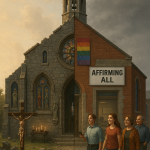 It’s hard to imagine just how profoundly different Catholics in 1800’s America felt from their neighbors. Much of this had to do with anti-Catholicism, which led them, writes Charles Morris, to “execute a remarkable emotional withdrawal from secular America.” As a result, Morris notes, there arose a “parallel of Catholic organizations of every variety”: academic societies, publishing houses, lawyers’ and doctors’ guilds, to name a few.
It’s hard to imagine just how profoundly different Catholics in 1800’s America felt from their neighbors. Much of this had to do with anti-Catholicism, which led them, writes Charles Morris, to “execute a remarkable emotional withdrawal from secular America.” As a result, Morris notes, there arose a “parallel of Catholic organizations of every variety”: academic societies, publishing houses, lawyers’ and doctors’ guilds, to name a few.
Catholics even had their own separate literary world, replete with “Catholic novelists” and “Catholic poets.” By the early twentieth century, Father John Banister Tabb (1845-1909) was one of the shining stars of American Catholic poetry. (Tabb Poetry Societies were common up through the 1950’s.) A Confederate veteran from a distinguished Southern family, Tabb converted to Catholicism and became a priest at age 39. He spent the rest of his life teaching seminarians English literature and writing poems on the side.
A descendant of George Washington, Tabb grew up on a plantation near Richmond amid, his biographer notes, “a multitude of slaves.” Tabb made little reference to slavery in his life, except in paternalistic terms. (One of his later poems, titled “Mammy,” pays tribute to his childhood nurse.) Educated by a private tutor, he was raised Episcopalian.
Yet Tabb was raised with “a dense ignorance of Catholicity.” When he met his first Catholic priest, he asked the man if his father had also been a priest. “No, my son,” the cleric gently replied.
As the Civil War broke out, Tabb enlisted in the Confederate Navy. For three years he ran Union blockades until captured. In a prison camp. he befriended another future poet, Sidney Lanier. Tabb never relinquished his devotion to the Confederacy. When a student suggested he visit the North, he replied: “I am a Rebel unredeemed and unredeemable, and should not feel at home there.” Like many of his former comrades, Tabb had little interest in the plight of the newly freed slaves. Although he wasn’t an avowed racist, neither his personal nor public writings show any interest in the subject.
After the war, Tabb taught in an Episcopalian school in Baltimore, where he befriended the rector, Alfred Curtis. A “High Church” Episcopalian, Curtis later converted to Catholicism and became Bishop of Wilmington, Delaware. As Tabb’s spiritual director, Curtis was a strong influence. Tabb soon “crossed the Tiber” not long thereafter. In his later years, he wrote: “I would have been a member of the Church years before if I had learned what the Catholic doctrines were.”
In 1874, Tabb entered St. Charles College, a seminary in Ellicott City, Maryland, where he would spend the rest of his life as a seminarian and a faculty member. For several years his ordination was postponed while he taught English at the college level. (The faculty at St. Charles was always short-handed.)
Tabb was a “born teacher,” reciting long passages of poetry and prose with “rare ease and force.” One student recalled him reciting Percy Bysshe Shelley’s “Ode to a Skylark”:
When he had finished he was on tiptoe at the opposite corner of the room, breathless, as if eager to follow the bird in its flight. Instinctively the class broke out in applause. He modestly suppressed our enthusiasm with the remark: ‘Gentlemen, did you see that skylark soar? If there is a single boy in this class who did not see that lark and hear him sing, I forbid him ever again to open a book of poetry, for it would be a sheer waste of time.’ Need it be said that most of those present saw the lark and heard him sing?
Later on Tabb would dedicate one of his books to his students “active and passive; perfect and imperfect; past, present and future.”
After his ordination in December 1884, Tabb soon published his first volume of poems. Over the nest 25 years he wrote nearly a dozen books, including an English textbook. His subjects varied between religion and nature; reviews tended to be fairly positive. Tabb took great pride in his accomplishments; one former student recalled: “of his own published works, he was a liberal donor.”
Tabb was widely published in magazines such as Harper’s Monthly, The Atlantic Monthly, and Cosmopolitan. Yet his main influence was in Catholic circles, where he soon became a minor celebrity. At the time, many American Catholics were highly proud of the fact that one of their own had made it in the literary world. Well into the twentieth century, his poems were standard reading in Catholic colleges and universities.
Tabb’s specialty was the short, epigrammatic poem. Of all his poems, perhaps the one that has survived best is the poem he wrote for St. Damien of Molokai, better know at the time as “Father Damien”:
O God, the cleanest offering
Of tainted earth below,
Unblushing to my feet we bring–
‘A leper white as snow!’
Described as a “spare, tall man,” Tabb never enjoyed good health. Toward the end of his life, blindness set in, but he still dictated poems to a student-secretary. After his death on November 19, 1909, Tabb was buried in his native Virginia, whose hills and mountains he loved so much and frequently visited. Despite his sizable literary output, Tabb remained first and foremost a priest-teacher forming future priests. As his eulogist put it, “his religion consisted not in sentiment, but in service.”
(*The above drawing of Father Tabb is by Pat McNamara.)










